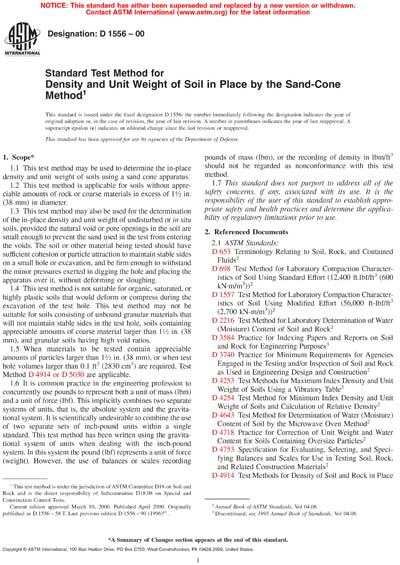Historical
ASTM D1556-00
Standard Test Method for Density and Unit Weight of Soil in Place by the Sand-Cone Method
1.1 This test method may be used to determine the in-place density and unit weight of soils using a sand cone apparatus.
1.2 This test method is applicable for soils without appreciable amounts of rock or coarse materials in excess of 1 1/2 in. (38 mm) in diameter.
1.3 This test method may also be used for the determination of the in-place density and unit weight of undisturbed or in situ soils, provided the natural void or pore openings in the soil are small enough to prevent the sand used in the test from entering the voids. The soil or other material being tested should have sufficient cohesion or particle attraction to maintain stable sides on a small hole or excavation, and be firm enough to withstand the minor pressures exerted in digging the hole and placing the apparatus over it, without deforming or sloughing.
1.4 This test method is not suitable for organic, saturated, or highly plastic soils that would deform or compress during the excavation of the test hole. This test method may not be suitable for soils consisting of unbound granular materials that will not maintain stable sides in the test hole, soils containing appreciable amounts of coarse material larger than 1 1/2 in. (38 mm), and granular soils having high void ratios.
1.5 When materials to be tested contain appreciable amounts of particles larger than 1 1/2 in. (38 mm), or when test hole volumes larger than 0.1 ft3 (2830 cm3) are required, Test Method D4914 or D5030 are applicable.
1.6 It is common practice in the engineering profession to concurrently use pounds to represent both a unit of mass (lbm) and a unit of force (lbf). This implicitly combines two separate systems of units, that is, the absolute system and the gravitational system. It is scientifically undesirable to combine the use of two separate sets of inch-pound units within a single standard. This test method has been written using the gravitational system of units when dealing with the inch-pound system. In this system the pound (lbf) represents a unit of force (weight). However, the use of balances or scales recording pounds of mass (lbm), or the recording of density in lbm/ft3 should not be regarded as non-conformance with this test method.
1.7 This standard does not purport to address all of the the safety concerns, if any, associated with its use. It is the responsibility of the user of this standard to establish appropriate safety and health practices and determine the applicability of regulatory limitations prior to use.
ASTM International [astm]

